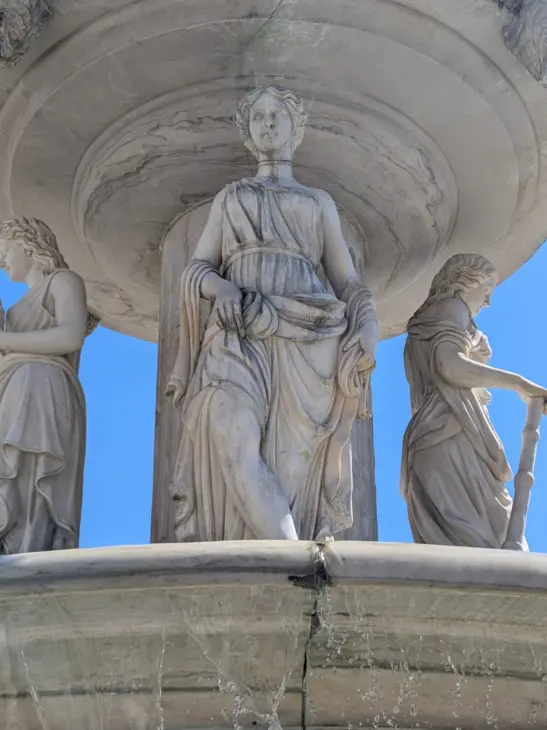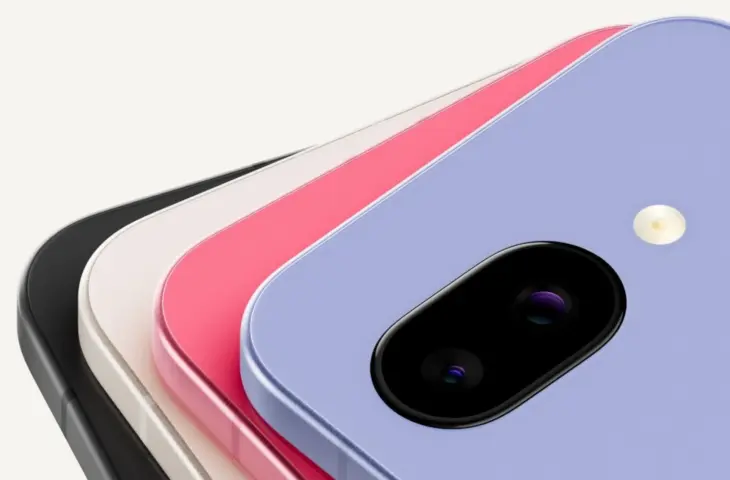Google makes somewhat strange choices for its mid-range Pixel 9a this year. We can only imagine how much better this device would have been if they had omitted those choices.
For a device priced at 549 euros, you get surprisingly powerful processing, a battery that can easily stand alongside top models, and a streamlined Android experience. Unfortunately, Google continues to stick to certain things, causing the smartphone to fall short in terms of charging speed and storage. Fortunately, it more than makes up for this in other areas.
Minimalist design
In terms of design, the Pixel 9a deviates from its predecessors. The familiar camera bar disappears and is replaced by a classic camera island. The back is made of matte plastic and available in white, black, or purple.
We received a purple review unit and weren’t particularly impressed by the new look. Nevertheless, everything feels solid, and with an IP68 certification. This means it can easily survive a rain shower or a fall into the bathtub. While this isn’t particularly special nowadays, it’s still a nice feature to have.
The aluminum sides reminded us of an iPhone, although the Pixel 9a does feel good in the hand. This good quality is almost negated by the black screen bezels. They are thick, noticeable, and make the smartphone look cheaper than it actually is, with a design that seems to come straight from 2012. We don’t immediately see a distinct (modern) Pixel identity.
Bright and smooth screen
Google equips the device with a 6.1-inch OLED display with a resolution of 2,400 x 1080 pixels. That’s relatively low. What immediately stands out positively is the brightness, which according to Google is an impressive 2,700 nits. This seems to match what we see. In full sunlight, text remains perfectly readable.
Just like with the Pixel 8a, Google once again opts for a dynamically adjustable refresh rate of 120 Hz. As a result, scrolling feels smooth, especially in combination with the powerful Tensor G4 chip, the same as in the Pixel 9 Pro XL (1,099 euros). A small detail is that the minimum brightness is a bit too high for our taste. This is noticeable when using your phone in bed at night and the screen remains too bright.
Benchmark topper
Under the hood is the Tensor G4 chip. It’s accompanied by 8 GB of RAM, the minimum according to Google to run Gemini AI locally in the form of Gemini Nano. The device scores exceptionally high and performs better than, for example, the Samsung Galaxy A36 and Nothing Phone 3a, and is closer in experience to the Pixel 9 than to the 8a.

While the device feels blazingly fast, some animations remain annoyingly slow. App icons only load after a few seconds, and the icons in the control center weren’t displayed at all. This can probably be fixed with a simple update, but in 2025, such issues are really not done.
Google equips the Pixel 9a with a Mali G615 GPU, bringing it on par with some premium models.

Cameras
The Pixel 9a has one main camera and an ultra-wide angle, thus missing an extra zoom lens. Nevertheless, these two cameras deliver sharp and clear images in various conditions. AI functions, such as Magic Editor and Audio Magic Eraser, are now also available on this model.
During the day, the colors stand out: buildings, artworks, and interior photos look realistic without being oversaturated. Photos of statues and buildings, taken with both lenses, are detailed and show that HDR is doing its job. Indoors or in the early evening, photos remain largely noise-free and natural.












Even at night, the 9a doesn’t disappoint. A night photo with the main camera shows how well the device performs in low light: streetlamps are not too bright, shadows remain dark with detail, and the colors in illuminated areas remain accurate. What really stands out is that the night mode doesn’t make the photo extremely bright, as is the case with some competitors.

The Pixel 9A proves that you can go surprisingly far with two lenses. For users who mainly take photos of people, buildings, art, and concerts, this is certainly sufficient. You just shouldn’t expect to be able to zoom in to the moon. Let this be a lesson for smartphone manufacturers who feel the urge to add a third, useless camera to their mid-range devices.
Battery
In our video test to measure battery life (in minutes), the Pixel 9a achieved 1,539 minutes. This scores much better than competing models. Even with intensive use, the device easily lasted until evening. With normal use, you’ll have 25 to 30 percent left over.

There’s only one painful drawback: charging is extremely slow. The Pixel 9a supports 23W wired and 7.5W wireless charging. That’s disappointing: after half an hour, you’ve barely recharged 40 percent, and a full charge takes more than 90 minutes. Wireless charging is a nice extra, but you should at least expect Qi2 instead of Qi 1.0.

Other devices like the Xiaomi 14T Pro (899 euros) show how it can be done better and charge in 25 minutes. Google is really lagging behind here.
Software, AI, and Storage
The Pixel 9a runs Android 15 and does so quickly and without bloatware. Furthermore, Gemini replaces Google Assistant, and it’s smarter and better integrated. You can translate live, recognize objects via the camera, and edit photos via the Magic Editor. All of this happens locally and surprisingly fast.
You don’t get the extensive Gemini Advanced features like screenshots that remember information or perform certain tasks in Gmail. You also don’t pay a monthly subscription for Gemini. Everything that is available works well.
Another drawback is the storage. The Pixel 9a has 128 GB of storage space, without the possibility of expansion via a microSD card. You can, of course, store your photo “s, video” s and other files in the cloud, where you get decent storage with a subscription. Those who don’t do this will quickly run into the storage limit. Another model with 256 GB easily costs 100 euros more. Other brands offer 256 GB as standard in this price range.
Conclusion
This is probably the most reliable model you can get for under 600 euros. Thanks to seven years of software updates, you’ll be set for quite a while. For that price, you get faster performance than you’d expect, a nice screen, useful AI functions, and a battery that lasts a long time.
If you can look past the drawbacks (icons that don’t load, storage, painfully slow charging, etc.), you may not be getting the best, but you’re definitely getting a more than decent Android device.
.pro’s
- Good battery life
- Realistic colors in photos
- Very fast performance
.contra’s
- Charging takes a very long time
- Limited zoom
- Storage could be more extensive
